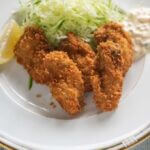
Crunchy outside and juicy inside, Deep-fried Crumbed Oysters is one of the best ways of eating oysters in my view. Shucked oysters are very fresh but expensive, so I used frozen oysters to make Deep-fried Crumbed Oysters. Watch the video.
Don't forget to see the section 'MEAL IDEAS' below the recipe card! It gives you a list of dishes that I have already posted and this recipe that can make up a complete meal. I hope it is of help to you.
- 10 frozen oysters (note 1)
- 1000ml/2.1pt water (note 2)
- 30g/1.1oz salt (note 2)
- Pepper
- 2 tbsp flour
- 1 egg beaten
- 1 cup Panko breadcrumbs (note 3)
- Oil for deep-frying
- 1 boiled egg finely diced
- 4 tbsp Kewpie mayonnaise (note 4)
- 1 tbsp gherkin/cornichon finely chopped
- 1 tbsp onion finely chopped
- 1 tsp lemon juice
- ½ tsp sugar
- ¼-½ tsp salt
- Pepper
- Shredded cabbage with cucumbers julienned (note 5)
- Japanese-style Tartar Sauce or tonkatsu sauce (note 6)
- Lemon wedges
-
Dissolve 30g/1.1oz salt in 1000ml/2.1pt water to make 3% salt water.
-
Put the frozen oysters in the salt water and leave them for 5-15 minutes (note 7) until the surface of the oysters is thawed, but inside is still frozen and hard.
-
Using paper towel, pat dry each oyster. Move to the next step without delay so that the oysters are still semi-frozen.
-
Sprinkle pepper over the oysters.
-
Place flour, egg and breadcrumbs in a shallow plate or bowl individually and line them up in this order.
-
Working one oyster at a time, coat an oyster with flour thoroughly, then place it in the egg and coat all over. Allow excess egg to drip, then transfer to the breadcrumbs.
-
Cover the entire oyster with breadcrumbs, making sure that a good layer of breadcrumbs is stuck on all around the oyster.
-
Repeat the steps 3 and 4 for the rest of the oysters.
-
Heat oil in a deep-frying pan to 160°C/320°F (note 8). The amount of oil should be about 3-3.5cm/1¼-1⅜” deep.
-
Gently place oysters into the oil. Depending on the size of the pan, you may need to fry in batches. Do not overcrowd the pan (note 9).
-
Fry for about 2½-3 minutes or until the surface of the oysters become light brown. Transfer the oysters to a tray with a cooling rack or lined with a couple of layers of paper towel.
-
When all the oysters are fried, turn the heat up to 180°C/356°F (note 8) and fry the oysters again (note 9) for 15 seconds or so until golden brown. Transfer the oysters to the tray.
-
Pile shredded cabbage on one side of a serving plate and put a lemon wedge next to it.
-
Place oysters leaning against the cabbage, placing them in the same direction, with the gills side facing upward.
-
If serving with Japanese-style Tartar Sauce, put the sauce on the side next to the oysters. If serving with Tonkatsu sauce, put the sauce in a separate jar.
-
Serve immediately while hot.
-
If your onion is extremely pungent, leave the chopped onions in water for 10 minutes. Drain through a fine-mesh sieve, then squeeze the water out.
-
Put all the Japanese-style Tartar Sauce ingredients in a bowl and mix well.
1. My frozen oysters weighed about 200g/7.1oz and there was minimum ice around the oysters. They were about 6cm/2⅜" long.
If you prefer, you can use fresh oysters or oysters in a jar. It is best to use 5-6cm/2-2⅜" long oysters for frying.
2. If you are not using frozen oysters, you don’t need these. Then you need to season oysters with salt when sprinkling pepper over them.
3. For Kaki Fry, I strongly recommend using panko, or even freshly grated bread. The large crumbs make the coating crunchy when fried.
4. Kewpie mayonnaise is not as sour as the Western-style mayonnaise. If you are substituting it with Western-style mayo, omit lemon juice.
5. Instead of adding cucumber pieces, you can place a sprig of parsley on top if you like.
6. I used Bulldog brand tonkatsu sauce. You can find more details about Bulldog sauces in my post Yakisoba.
7. Depending on the water and room temperature, the time taken to partially thaw varies.
8. Add a couple of breadcrumbs into the oil and if the bubbles around the crumbs are small and slowly increasing, it is about 160°C/320°. If the crumbs are surrounded by lots of bubbles, it is about 180°C/356°F.
9. I used a small pan and fried the oysters in 2 batches.
Every time you remove oysters from the oil and before frying the next batch of oysters, scoop the crumbs from the oil using a flat sieve with fine mesh (see the video). This will prevent crumbs left in the oil from getting overcooked and blackened. The burnt crumbs tend to stick to the crumbs around the oysters and make them look dirty.
10. Nutrition per serving. It assumes that the oil absorption rate is 30% of the total weight of oysters.
serving: 163g calories: 453kcal fat: 32g (49%) saturated fat: 3g (15%) trans fat: 0.2g polyunsaturated fat: 6.2g monounsaturated fat: 21g cholesterol: 92mg (31%) sodium: 892mg (37%) potassium: 241mg (7%) carbohydrates: 28g (9%) dietary fibre: 1.6g (6%) sugar: 1.7g protein: 14g vitamin a: 6.3% vitamin c: 12% calcium: 5.4% iron: 36%